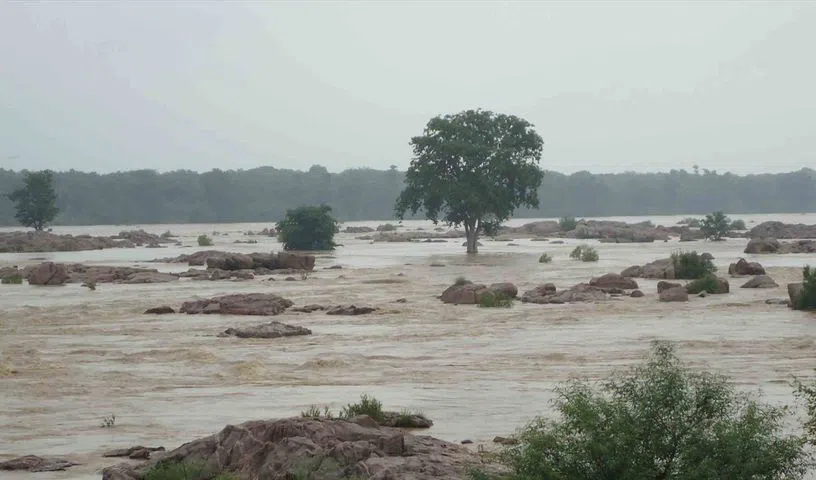
With a thoughtful and integrated approach, India can transform its rivers into a network of prosperity but caution must remain the watchword
The idea of interlinking rivers, often discussed in modern engineering and environmental discourse, finds its origins deeply embedded in Indian mythology and the Vedas. The matted locking of Lord Shiva is believed to have controlled the Ganga to protect lifeforms. Similarly, the tale of the sage Agastya drinking the ocean to control floods reflects an early understanding of managing water overflow. The practice of undertaking pilgrimages to river confluences, such as the Kumbh Mela and Chhath Puja, highlights the spiritual importance of rivers.
Starting with Indus Valley
The Indus Valley Civilisation (2600–1900 BCE), one of the world’s earliest urban cultures, displayed advanced water management systems, including reservoirs, wells, canals and drainage systems. These structures suggest an early understanding of managing water flow effectively. While there is no direct evidence of river linking during this era, the efficient use of water resources set a precedent for future endeavours.
The Mauryan Empire (321–185 BCE) marked the next significant phase in water management. Kautilya’s Arthashastra, an ancient treatise on statecraft, emphasises the importance of irrigation for agriculture and prosperity. Ashoka’s reign (268–232 BCE ) and Chola Dynasty (9th–13th century CE) saw the construction of canals and water tanks to harness river waters, laying the groundwork for more ambitious projects in later centuries.
The Grand Anicut (Kallanai) canal, built on Kaveri River, is one of the oldest functioning water diversion structures in the world primarily designed for irrigation
The Grand Anicut (Kallanai) canal, built on the Kaveri River, is one of the oldest functioning water diversion structures in the world. While primarily designed for irrigation, such projects hinted at the potential of interconnecting rivers to maximise agricultural productivity. In North India, the Mughal emperors (16th–18th century CE) continued this tradition. Akbar and his successors undertook large-scale canal construction such as the Nahr-i-Bahisht (Heavenly Canal), which linked several tributaries of the Yamuna to enhance irrigation in the Delhi-Agra region.
The British colonial administration (1757–1947) introduced large-scale irrigation projects along with railways marking a shift toward modern infrastructure development. British engineer Sir Arthur Cotton is known as the pioneer of river-linking in India. His vision of interlinking rivers in the Madras Presidency was aimed at preventing famines and boosting agricultural output. The construction of the Krishna-Godavari Canal in the 1850s facilitated irrigation and navigation. While the focus was primarily regional, it laid the conceptual foundation for larger inter-basin water transfer schemes.
Waters of World
The ancient civilisations, from Mesopotamia to China, built extensive canal networks to irrigate fields and sustain growing populations. In medieval Europe, waterways were developed for both irrigation and navigation to manage water resources through large-scale projects.
In the 20th century, technological advancements of the Industrial Revolution paved the way for ambitious water management projects. The Tennessee Valley Authority (TVA), Central Valley Project (CVP) and Colorado River Aqueduct in the United States, and the Siberian river reversal projects in the former Soviet Union are notable examples of inter-basin water transfer systems. These initiatives highlighted not just the transformative potential of river linking but also the associated risks and challenges.
The Tennessee Valley Authority, Central Valley Project and Colorado River Aqueduct in the US, and the Siberian River reversal projects in the former Soviet Union are notable examples of inter-basin water transfer systems
China’s South-to-North Water Diversion Project aims to transfer water from the Yangtze River Basin in the south to the arid northern regions, including Beijing. Likewise, in Africa, the Congo River Inter-basin Water Transfer project, for example, aims to channel water from the Congo Basin to Lake Chad. Australia’s Murray-Darling Basin Plan is a regional initiative that seeks to balance water distribution among competing uses, including agriculture, urban consumption and environmental conservation.
National Priority in India
After India gained independence, equitable water distribution became a national priority. The country emphasised the role of dams and irrigation in nation-building with projects like the Bhakra Nangal Dam and Hirakud Dam. Dr KL Rao, a civil engineer and former Union Minister for Irrigation and Power, proposed the Ganga-Cauvery Link Canal Project in 1972, which envisioned connecting rivers to address water shortages in south India.
Captain Dastur, a retired pilot, proposed the Garland Canal Project in 1977, involving two canal systems running across India to link rivers for equitable water distribution. In 1980, the Ministry of Water Resources introduced the National Perspective Plan (NPP) for the interlinking of rivers (ILR) with the National Water Development Agency (NWDA in 1982). The NPP proposed the ambitious idea of interlinking India’s rivers to address water scarcity, mitigate floods, and ensure sustainable agricultural growth. It envisioned 30 inter-basin link projects divided into two components — the Himalayan Component (14 to transfer surplus water from the Ganga and Brahmaputra to drought-prone regions) and the Peninsular Component (16 focused on linking the Mahanadi, Godavari, Krishna, and Kaveri).
In the 21st century, ILR has gained renewed attention due to recurring droughts, erratic monsoons and rising water demand. Former President Dr APJ Kalam is credited with bringing ILR to address water scarcity and promote sustainable development. Former Prime Minister Atal Bihari Vajpayee set up a task force in 2002 to study the feasibility and implementation of the project.
China’s South-to-North Water Diversion Project is the largest river-linking initiative in the world aimed at transferring water from the Yangtze River Basin in the south to the arid northern regions, including Beijing
A ‘Special Committee on Interlinking of Rivers’ was constituted in 2014 for the implementation of ILR. A ‘Task Force for Interlinking of Rivers’ was also constituted in 2015 to expedite the works. In 2016, the government established the National Interlinking of Rivers Authority (NIRA). Its mandate includes addressing legal, environmental and technical challenges associated with inter-basin water transfers. The key projects are: Godavari-Krishna Link which was completed in 2015 to divert surplus water from the Godavari River to the Krishna River, ensuring water availability for irrigation and drinking purposes in Andhra Pradesh and Telangana, and Damanganga-Pinjal and Par-Tapi-Narmada Links to augment water supply in western India.
Ken-Betwa Link Project
The Ken-Betwa Link Project (KBLP) is the first link project under NPP for which ILR implementation has been initiated. This seeks to transfer surplus water from the Ken River in Madhya Pradesh to the Betwa River in Uttar Pradesh. Ten districts of Madhya Pradesh, including Chhatarpur, Tikamgarh, Niwari, Panna, Damoh, and Sagar, will benefit from improved irrigation facilities.
Districts like Banda, Mahoba, Lalitpur, and Jhansi in Uttar Pradesh’s Bundelkhand region will also gain from this initiative. Along with this, the hydropower projects will contribute more than 100 Mw as green energy. A plan worth Rs 45,000 crore ($5.5 billion at 2020-21 price level), including a central support of Rs 39,317 crore ($4.5 billion), is in place.
The project will create employment opportunities as well as strengthen the rural economy, irrigating approximately 11 lakh hectares (11,000 sqkm) of land, and address water scarcity in the Bundelkhand region. While the KBLP has multiple benefits, it has faced criticism for environmental impacts.
Significant Drawbacks
One of the most significant criticisms of ILR is altering natural river systems which can disrupt ecosystems, affecting aquatic habitats, and threaten biodiversity — disturb migratory patterns of fish and birds, and degrade water quality. The construction of reservoirs and canals often leads to large-scale deforestation and land submergence, habitat loss, loss of flora and fauna and increased greenhouse gas emissions. ILR projects can displace communities, particularly indigenous populations, and disrupt traditional livelihoods and cultural heritage. Ensuring fair compensation and effective rehabilitation for affected populations remains a contentious issue.
The ILR projects are capital-intensive, requiring substantial investment in infrastructure. For example, the estimated cost of the National River Linking Project runs into trillions of rupees, raising questions about the project’s economic viability. Developing countries, in particular, may struggle to allocate the necessary resources without jeopardizing other development priorities. Technical challenges, such as constructing canals across diverse terrains, further complicate implementation and maintenance. With climate change altering precipitation patterns and glacier melt rates, the availability of surplus water in donor basins is uncertain. This unpredictability undermines the core premise of river-linking.
Water-sharing is a politically sensitive issue in many countries, including India. Here, 17 of India’s 18 major rivers are shared by two or more States. Krishna, Narmada, Godavari, Ravi and Beas and Cauvery are known for disputes over the sharing of the water. Building consensus among States and neighbouring countries is crucial for project success. For example, international implications, particularly with neighbouring countries like Bangladesh, which depend on rivers originating in India, add another layer of complexity.
Water is becoming an increasingly scarce resource in many regions of the country. At the time of independence, India’s population was less than 400 million, and per capita water availability exceeded 5,000 m³ per year. Today, this has dropped to approximately 1500 m³ per year. While this level is not alarmingly low compared to some other nations, India’s water availability challenges are exacerbated by significant spatial and temporal variations. Certain regions receive little to no rainfall, while others experience heavy rainfall, leading to severe flooding during the monsoon season.
For instance, the flow of the Ganga at the Farakka Barrage (West Bengal) may drop below 40,000 cusecs during March-April but can exceed 2,00,000 cusecs in July-August, often resulting in devastating floods. Similarly, the Brahmaputra poses comparable risks during the southwest monsoon in July-August. In contrast, droughts are a recurring issue, impacting large areas in southern, central, eastern, and north-western States.
Agriculture remains the largest consumer of water, using around 90% of the total supply. In predominantly agricultural States like Punjab and Haryana, this is even higher, reaching 95%. Incidentally, agriculture’s share in the nation’s GDP and GVA has dropped sharply over recent decades, from 35% to 15%. Nevertheless, the sector still provides employment to about 58% of the workforce and serves as the primary livelihood source for 70% of the rural population and 80% of its impoverished section.
Uneven Availability
India’s water availability is uneven, with States like Punjab and Kerala having surplus water while others like Rajasthan and Tamil Nadu face acute shortages. The ILR can ensure a more equitable distribution of resources. By transferring surplus water to deficit areas, ILR can act as a buffer against flooding and drought, enhancing agricultural productivity, reducing dependency on erratic rainfall and safeguarding livelihoods. Reservoirs and canals can offer opportunities to generate hydroelectric power, contributing to India’s renewable energy goals. A national water grid can foster inland navigation, reducing transportation costs and boosting trade. Additionally, well-maintained water bodies can serve as hubs for tourism, generating employment and revenue.
India’s National River Linking Project is one of the most ambitious programmes globally. It envisions connecting 37 rivers through such 30 inter-linking projects to create a national water grid. Pre-Feasibility Reports of all the 30 links, Feasibility Reports of 24 links and Detailed Project Reports of 11 links have been completed
By integrating ILR projects into broader water management frameworks, countries can minimise risks and maximise benefits. Robust Environmental Impact Assessments (EIAs) must precede project approvals, ensuring that ecological and social costs are minimised. Mitigation measures, such as constructing fish ladders and preserving wetlands, should be integral to project design. Participatory decision-making via engaging local communities, civil society and experts in the planning process can build consensus and address concerns. Transparent communication about the project’s benefits and challenges is crucial for public acceptance.
Given the transboundary nature of rivers, fostering cooperation with regional stakeholders and neighbouring countries is essential. Water-sharing agreements, based on principles of equity and sustainability, can prevent conflicts and promote mutual benefits.
The future of ILR lies in striking a balance between development and sustainability. Technological advancements, such as satellite monitoring and predictive modelling, can improve project planning and minimise environmental impacts. Advanced technologies, such as remote sensing, Global Positioning System (GPS) and Geographic Information Systems (GIS), can enhance project planning and execution. Real-time data on water availability and usage can improve decision-making. Dedicated agencies with clear mandates can oversee the complex logistics of ILR projects.
Adaptive management involves continuously monitoring and adjusting water management strategies based on changing conditions and new information. This approach can help countries respond to the dynamic challenges of climate change, population growth and urbanisation. Alternative solutions such as rainwater harvesting, groundwater recharge and wastewater recycling should be given similar importance. These methods can complement ILR projects and reduce the pressure on natural water systems.
From ancient engineering marvels to modern mega-projects, the journey of ILR reflects the evolution of water management strategies in the subcontinent. As India moves forward, lessons from the past must inform future endeavours. With a thoughtful and integrated approach, India can transform its rivers into a network of prosperity, ensuring water security for generations to come. However, caution must remain the watchword, for the stakes are as high as the aspirations driving this monumental endeavour.







